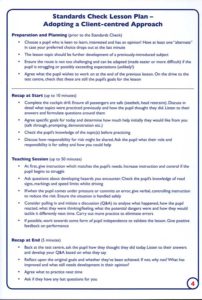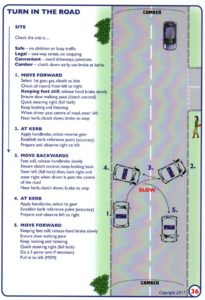Core Subject 7 – Turn in the Road
Use ATS lesson plan on page 4 and diagram on page 36
Introduction
Whilst this is no longer one of the manoevures in the driving test, it is a very useful manoevure to teach good clutch control and steering.
In this topic you will need to teach the pupil how to control the car in a confined space whilst being aware of other road users. Observing the pupil’s actions (eyes, hands, feet) closely to predict any faults so that you can nip them in the bud will help with control and pupil confidence. Choose a quiet, flat and wide road with good sight lines in each direction.
The Lesson
At the start, briefly introduce the lesson, agree goals and how much help the pupil wants when they carry out their first practice. Discuss potential dangers and how thee risks could be managed by you and the pupiil.
The briefing on page 36 of the ATS should help the pupil understand how to carry out the exercise but don’t expect much of the information to have been retained when you practice the exercise. be prepared to increase your controlling instruction if driver faults and lack of control are evident.
Practical Instruction
It is important to balance your instruction by teaching and controlling three important elements – Steering, Observations and Speed (SOS). When the vehicle is moving, encourage rapid steering to full lock. Don’t accept any dry steering and ensure if it does occur the pupil understands the damaging effect on the vehicle.
Speed control creates time for steering and all-round observations. Help the pupil with their clutch or brake control by using the dual controls if necessary. However, this should be the exception not the rule! Using terms like, “thickness of a £1 coin” might help a pupil understand how a tiny movements on the clutch pedal can achieve the desired outcome.
Finally, a manoeuvre exercise like this one cannot be achieved without good all-round observations by pupil and instructor. Assume everyone else has priority over you and agree a goal that you will see others well before they are close to you.
Summary
Focus your attention on the coordination of the controls but keep a sharp eye out for other road users. After each leg of the manoeuvre, elicit feedback from your student on how they performed that part and what to do to improve on it next time.
Private Practice
Practice talking yourself through the manoeuvre saying the talk through before carrying out the actions. Analyse what you do with eyes, hands and feet to steer briskly and keep the vehicle moving slowly.
Tasks to complete
- Fill in the blanks on the worksheet – Turn in the Road ( you can download it in word, complete it and upload it to your course for us to forward it to your trainer)
- Complete the same worksheet in your workbook
- Complete the Quiz
- Send in 10 questions on this subject (Open questions such as who, what, when , why and how) – Again complete it and upload to be forwarded to your trainer)
- Make a note of those questions in the back of your workbook.
- Arrange a lesson / online session with your trainer and deliver them a brief on this subject.


